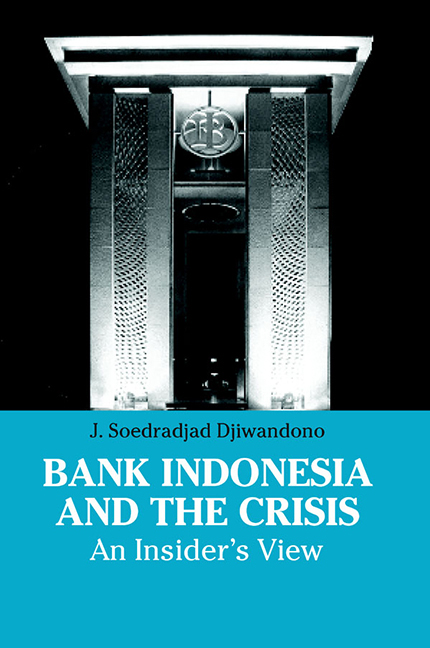Book contents
- Frontmatter
- Dedication
- Contents
- List of Tables
- Acknowledgements
- Glossary
- Prologue: The Crisis and Me
- 1 Introduction
- 2 Origin of the Crisis and Early Responses
- 3 Stabilization and Reform Programmes
- 4 Poor Programme Implementation
- 5 Stronger Programme with Weak Commitment
- 6 Bank Indonesia and the Crisis
- 7 Lessons from the Crisis
- 8 Epilogue
- Postscript
- Notes
- References
- Index
- About the Author
Prologue: The Crisis and Me
Published online by Cambridge University Press: 21 October 2015
- Frontmatter
- Dedication
- Contents
- List of Tables
- Acknowledgements
- Glossary
- Prologue: The Crisis and Me
- 1 Introduction
- 2 Origin of the Crisis and Early Responses
- 3 Stabilization and Reform Programmes
- 4 Poor Programme Implementation
- 5 Stronger Programme with Weak Commitment
- 6 Bank Indonesia and the Crisis
- 7 Lessons from the Crisis
- 8 Epilogue
- Postscript
- Notes
- References
- Index
- About the Author
Summary
During the Wahid era Indonesians started to get used to news about the dismissals of government officials, including cabinet ministers and generals, beginning with the dismissals of the then Minister for Trade and Industry Jusuf Kalla and the Minister of Public Enterprises Laksamana Sukardi in July 2000. To make things worse, a dismissal was usually preceded by rumours and media reports.
However, my dismissal as Governor of the Bank Indonesia by President Soeharto several weeks before the end of my term attracted unusually widespread public and media interest. At the same time, the reasons for this unprecedented sacking of a Central Bank governor have remained a mystery, hence my justification for writing this book.
Dismissed as Bank Indonesia Governor
I was dismissed from my post as Governor of Bank Indonesia through a presidential decree on 11 February 1998. Official release from the post took place at the installation of my successor, Dr Sjahril Sabirin, on 19 February 1998. The new governor and myself undertook the legal transfer of authority at Bank Indonesia on 23 February 1998, thus formally ending my tenure, which had begun upon the installation of Development Cabinet VI on 21 March 1993.
My dismissal was unusual because on previous occasions, at least since 1983, the replacement of the central bank governor had usually been in tandem with the change of cabinet ministers. Since 1983, the position had also been accorded a state minister of cabinet status. Indeed, in this system the post of Central Bank Governor was equivalent to the posts of the Attorney General and the Commander of the Armed Forces — all three had state ministerial status. On one or two occasions the handovers were one or two days later than those of the cabinet ministers, but never weeks apart. The new cabinet, Development Cabinet VII, was installed on 16 March 1998 but my dismissal and the legal transfer of authority were all several weeks prior to this.
What seemed to be the reason behind the President's haste? Some government officials immediately made the standard comment that the replacement of an official was the prerogative of the President and that it was “normal”.
- Type
- Chapter
- Information
- Bank Indonesia and the CrisisAn Insider's View, pp. 1 - 12Publisher: ISEAS–Yusof Ishak InstitutePrint publication year: 2005

